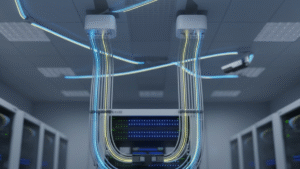You expect your small printer just to work, but if it keeps freezing, overheating, or shutting down, the real problem might be your power adapter.
An external switching power adapter gives small printers steady, clean power. It prevents voltage spikes, reduces heat, and protects vital parts, helping the printer work better and last longer.
I’ve worked on compact printers used in mobile offices, point-of-sale counters, and shipping stations. Most complaints were related to print issues or unexpected reboots. But the root cause? Often the power adapter. Replacing a cheap adapter with a certified switching type fixed the problem instantly. That’s when I realized—power stability isn’t just about power. It’s about printer health.

Why Is Stable Power So Important for Small Printers?
Your printer’s performance depends on more than just its design—it needs the right kind of power to function properly.
Fluctuating voltage or ripple noise can damage heating elements, motors, and chips in small printers. A stable power source keeps the system running safely and efficiently.
How Unstable Power Affects Key Parts
| Printer Component | What Goes Wrong with Poor Power | Long-Term Effect |
|---|---|---|
| Heating Element | Uneven heat = faded or patchy prints | Burnout or lower efficiency |
| Stepper Motors | Inconsistent rotation or jitter | Misalignment, gear wear |
| Control Chips | Communication errors, system crashes | PCB degradation or chip failure |
| LCD Interface | Screen flickering, input lag | Poor user experience |
The truth is, unstable power doesn’t just cause momentary glitches. It wears the system down, silently. That wear adds up fast, especially in 24/7 environments.
How Does a Switching Adapter Keep Things Cool?
Excessive heat is a silent killer for electronics, and small printers are no exception.
Switching power adapters wastes less energy, so they stay cooler. This helps the printer avoid thermal buildup, which reduces print head wear and logic board strain.
Real Results from a Simple Swap
In one warehouse project, we swapped out bulky linear adapters with efficient switching types. Same specs—12V, 3A. But the results spoke for themselves:
| Metric | Linear Adapter | Switching Adapter |
|---|---|---|
| Adapter Temperature | 68°C | 45°C |
| Printer Surface Temp | 56°C | 42°C |
| Print Failures/week | 9+ | 1 or less |
What changed? Nothing inside the printer. Just a better power supply outside. That reduced system stress and kept operations running smoother for months.

Can a Good Adapter Protect Your Printer from Power Surges?
Absolutely. A proper adapter doesn’t just provide power—it also guards against bad power.
Top-tier external adapters come with built-in protection: over-voltage, over-current, and short-circuit safeguards. These protect your printer when the power gets unpredictable.
Safety Features That Matter
| Protection Feature | Why It’s Important |
|---|---|
| Over-voltage Protection | Keeps chips and boards from frying |
| Over-current Protection | Prevents overload on motors or heads |
| Short-circuit Shutdown | Saves internal PCB from permanent damage |
| EMI/EMC Shielding | Reduces signal interference |
In one kiosk rollout I joined, we used IEC/EN-approved adapters with full protection. Over 6 months, return rates on printers dropped by more than half. It wasn’t luck. It was clean power.
Why External Power Supplies Are Smarter Than Internal Ones
Some printers still use built-in power modules, but external ones are usually the smarter choice.
External adapters isolate heat, reduce repair complexity, and make upgrades easy. If something fails, you swap the adapter, not the whole printer.
Pros and Cons: External vs Internal Power
| Type | Pros | Cons |
|---|---|---|
| External Adapter | Less heat, easier to replace | Needs cable management |
| Internal Supply | Sleek design, fewer loose parts | Harder to repair, more heat inside |
When it comes to long-term use, I always recommend external power for compact printers—especially in field or retail environments where uptime is everything.
Conclusion
The right external switching power adapter can make your small printer more reliable, more efficient, and last longer, without any changes to the printer itself.




